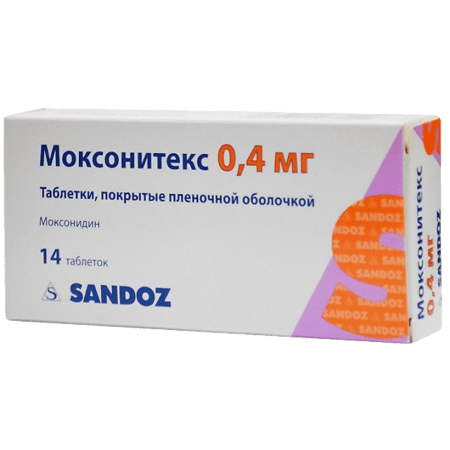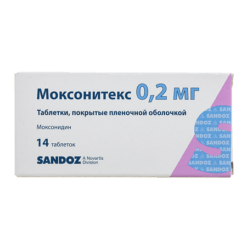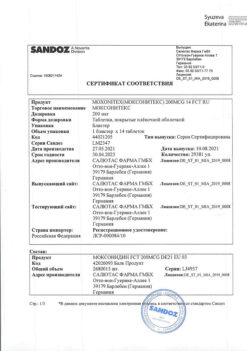No products in the cart.
Moxonitex, 0.4 mg 14 pcs
€1.00
Out of stock
(E-mail when Stock is available)
Description
Moxonitex is a selective imidazoline receptor agonist. It is responsible for reflex control of the sympathetic nervous system (receptors are localized in the ventero-lateral part of the medulla oblongata). Slightly binds to central α2-adrenoreceptors, reduces systolic and diastolic BP with single and prolonged use.
Long-term use decreases myocardial hypertrophy of the left ventricle, levels the signs of myocardial fibrosis microarteriopathy, normalizes myocardial capillary blood supply, decreases PPS, pulmonary vascular resistance, while cardiac output and HR do not change significantly.
Treatment decreases the activity of norepinephrine and epinephrine, renin, angiotensin II at rest and during exercise, atrial natriuretic peptide (during exercise) and plasma aldosterone.
Limits tissue resistance to insulin by 21% compared to placebo in obese patients and insulin-resistant patients with moderate severity of arterial hypertension, stimulates the release of growth hormone. Does not affect the metabolism of glucose and lipids.
The duration of action is more than 12 hours.
Pharmacokinetics
Intake
After oral administration the absorption is 90%. The absorption is not influenced by food intake. With a single oral administration the bioavailability is 88%. Cmax in plasma is determined 30-180 min after oral administration and is 1-3 ng/ml.
The interval between reaching Cmax and a marked decrease in BP at rest differs on average by 10%, at load by 7.7%.
Distribution
The binding to plasma proteins is – 7%. Vd – 1.4-3 l/kg. It penetrates through the barrier membrane. It does not cumulate with prolonged use.
T1/2 – 2-3 hours. Excreted by the kidneys – 90% (50-75% – unchanged, 20% – as metabolites).
Pharmacokinetics in special clinical cases
Moxonidine is excreted in small amounts by hemodialysis. No significant differences in pharmacokinetics were found in young and elderly patients.
In patients with moderate renal impairment (CK 30-60 ml/min) and severe renal impairment (CK less than 30 ml/min), plasma Css and terminal T1/2 is approximately 2 and 3 times (respectively) higher than in patients with arterial hypertension with normal renal function (CK greater than 90 mL/min). Therefore, in patients with moderate renal insufficiency, the drug should be prescribed with caution and its dose should be adjusted individually.
Indications
Indications
Arterial hypertension.
Pharmacological effect
Pharmacological effect
Moxonitex is a selective agonist of imidazoline receptors. Responsible for reflex control of the sympathetic nervous system (receptors are localized in the venterolateral medulla oblongata). Slightly binds to central α2-adrenergic receptors, reduces systolic and diastolic blood pressure with single and long-term administration.
With long-term use, it reduces left ventricular myocardial hypertrophy, eliminates the signs of myocardial fibrosis and microarteriopathy, normalizes capillary blood supply to the myocardium, reduces peripheral vascular resistance, pulmonary vascular resistance, while cardiac output and heart rate do not change significantly.
During treatment, the activity of norepinephrine and epinephrine, renin, angiotensin II at rest and during exercise, atrial natriuretic peptide (with exercise) and plasma aldosterone decreases.
Reduces tissue resistance to insulin by 21% compared to placebo in obese patients and insulin-resistant patients with moderate arterial hypertension, stimulates the release of growth hormone. Does not affect the metabolism of glucose and lipids.
Duration of action – more than 12 hours.
PHARMACOKINETICS
Suction
After taking the drug orally, absorption is 90%. Food intake does not affect the amount of absorption. With a single oral dose, bioavailability is 88%. Cmax in blood plasma is determined 30-180 minutes after oral administration and is 1-3 ng/ml.
The interval between reaching Cmax and a pronounced decrease in blood pressure at rest differs by an average of 10%, and during exercise – by 7.7%.
Distribution
Plasma protein binding is 7%. Vd – 1.4-3 l/kg. Penetrates through the BBB. Does not accumulate with prolonged use.
Removal
T1/2 – 2-3 hours. Excreted by the kidneys – 90% (50-75% unchanged, 20% in the form of metabolites).
Pharmacokinetics in special clinical situations
Moxonidine is excreted in small quantities during hemodialysis. No significant differences in pharmacokinetics were found in young and elderly patients.
In patients with moderate renal failure (creatinine clearance 30-60 ml/min) and severe renal failure (creatinine clearance less than 30 ml/min), plasma Css and final T1/2 are approximately 2 and 3 times (respectively) higher than in patients with arterial hypertension with normal renal function (creatinine clearance more than 90 ml/min). Therefore, in patients with moderate renal failure, the drug should be prescribed with caution and its dose should be selected individually.
Special instructions
Special instructions
During treatment, regular monitoring of blood pressure, heart rate and ECG is required.
If it is necessary to cancel simultaneously taken beta-blockers and Moxonitex, beta-blockers are canceled first, and only after a few days – Moxonitex. You should stop taking Moxonitex gradually.
Impact on the ability to drive vehicles and operate machinery
The effect of Moxonitex on the ability to drive vehicles or operate machinery has not been studied. Taking into account the possible occurrence of dizziness and drowsiness, patients should be careful when engaging in potentially hazardous activities, such as driving or operating equipment that require increased concentration.
Active ingredient
Active ingredient
Moxonidine
Composition
Composition
Active ingredients:
moxonidine 400 mcg;
Excipients:
lactose monohydrate,
povidone K25,
crospovidone,
magnesium stearate.
Film shell composition:
opadry Y 1 7000 (titanium dioxide, hypromellose, macrogol 400), red iron oxide dye.
Contraindications
Contraindications
history of angioedema;
SSSU or sinoatrial block;
AV block II and III degrees;
severe bradycardia (less than 50 beats/min at rest);
severe heart rhythm disturbances;
chronic heart failure (III-IV functional class according to the NYHA classification);
unstable angina;
severe liver failure;
severe renal failure (creatinine clearance less than 30 ml/min, serum creatinine more than 160 µmol/l);
age under 18 years;
lactation period;
galactose intolerance, lactase deficiency or glucose-galactose malabsorption syndrome;
hypersensitivity to moxonidine or any other component of the drug.
The drug should be used with caution and under the supervision of a physician in patients who have recently suffered a myocardial infarction or with peripheral circulatory disorders (intermittent claudication, Raynaud’s syndrome); in patients with moderately severe renal dysfunction (creatinine clearance 30-60 ml/min; serum creatinine 105-160 µmol/l), with liver dysfunction, pregnancy, depression, glaucoma, epilepsy, Parkinson’s disease.
Side Effects
Side Effects
From the cardiovascular system: rarely – symptoms of vasodilation; sometimes – a pronounced decrease in blood pressure, syncope, Raynaud’s syndrome, peripheral edema.
From the side of the central nervous system: often – dizziness, headache, drowsiness, increased fatigue, sleep disturbance; sometimes – paresthesia, depression, anxiety.
From the digestive system: often – dryness of the oral mucosa, nausea, anorexia, constipation.
From the genitourinary system: sometimes – urinary retention or incontinence, impotence and/or decreased libido.
On the part of the sensory organ: sometimes – dry eyes, causing itching or a burning sensation.
Allergic reactions: sometimes – urticaria, itching, exanthema, angioedema.
Other: sometimes – gynecomastia, soreness of the parotid glands.
Interaction
Interaction
When moxonidine is co-administered with other antihypertensive drugs, the effect is mutually enhanced.
Beta-blockers increase bradycardia and the severity of negative ino- and dromotropic effects.
Moxonidine enhances the hypotensive effect of ethanol, sedatives, slow calcium channel blockers (dihydropyridine derivatives).
Moxonidine should not be used concomitantly with tricyclic antidepressants.
Tolazoline dose-dependently reduces the hypotensive effect of moxonidine.
Overdose
Overdose
Symptoms: headache, marked decrease in blood pressure, bradycardia, palpitations, weakness, drowsiness, dry oral mucosa; rarely – vomiting and epigastric pain. Paradoxical arterial hypertension and hyperglycemia are potentially possible.
Treatment: symptomatic. There is no specific antidote. If there is a pronounced decrease in blood pressure, it is recommended to restore bcc through fluid administration. α-adrenergic receptor antagonists can reduce or eliminate transient arterial hypertension during an overdose of moxonidine.
Storage conditions
Storage conditions
At a temperature not exceeding 25 °C
Shelf life
Shelf life
2 years
Manufacturer
Manufacturer
Salutas Pharma GmbH, Germany
Additional information
| Shelf life | 2 years |
|---|---|
| Conditions of storage | At a temperature not exceeding 25 °C |
| Manufacturer | Salutas Pharma GmbH, Germany |
| Medication form | pills |
| Brand | Salutas Pharma GmbH |
Other forms…
Related products
Buy Moxonitex, 0.4 mg 14 pcs with delivery to USA, UK, Europe and over 120 other countries.


















